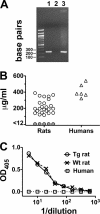Enhanced bacteremia in human factor H transgenic rats infected by Neisseria meningitidis
- PMID: 22104107
- PMCID: PMC3264313
- DOI: 10.1128/IAI.05604-11
Enhanced bacteremia in human factor H transgenic rats infected by Neisseria meningitidis
Abstract
Neisseria meningitidis binds the complement downregulating protein, factor H (fH), which enables the organism to evade host defenses. Two fH ligands, fHbp and NspA, are known to bind specifically to human fH. We developed a human fH transgenic infant rat model to investigate the effect of human fH on meningococcal bacteremia. At 18 h after intraperitoneal challenge with 560 CFU of group B strain H44/76, all 19 human fH-positive rats had positive blood cultures compared to 0 of 7 human fH-negative control littermates (P < 0.0001). Human fH-positive infant rats also developed bacteremia after challenge with isogenic mutants of H44/76 in which genes encoding fHbp and NspA (ΔfHbp ΔNspA mutant) or the lipooligosaccharide sialyltransferase (Δlst mutant) had been inactivated. A fully encapsulated ΔfHbp ΔNspA Δlst mutant unable to sialylate lipooligosaccharide or bind human fH via the known fH ligands did not cause bacteremia, which argued against global susceptibility to bacteremia resulting from random integration of the transgene into the rat genome. In vitro, the wild-type and ΔfHbp ΔNspA mutant strains were killed by as little as 20% wild-type infant rat serum. The addition of 3 μg of human fH/ml permitted survival of the wild-type strain in up to 60% infant rat serum, whereas ≥33 μg of human fH/ml was required to rescue the ΔfHbp ΔNspA mutant. The ability of meningococci lacking expression of fHbp and NspA to cause invasive disease in human fH transgenic rats and to survive in wild-type infant rat serum supplemented with human fH indicates an additional human fH-dependent mechanism of evasion of innate immunity.
Figures






Similar articles
-
fH-dependent complement evasion by disease-causing meningococcal strains with absent fHbp genes or frameshift mutations.Vaccine. 2013 Aug 28;31(38):4192-9. doi: 10.1016/j.vaccine.2013.06.009. Epub 2013 Jun 17. Vaccine. 2013. PMID: 23791680 Free PMC article.
-
The meningococcal vaccine candidate neisserial surface protein A (NspA) binds to factor H and enhances meningococcal resistance to complement.PLoS Pathog. 2010 Jul 29;6(7):e1001027. doi: 10.1371/journal.ppat.1001027. PLoS Pathog. 2010. PMID: 20686663 Free PMC article.
-
Factor H-dependent alternative pathway inhibition mediated by porin B contributes to virulence of Neisseria meningitidis.mBio. 2013 Oct 15;4(5):e00339-13. doi: 10.1128/mBio.00339-13. mBio. 2013. PMID: 24129254 Free PMC article.
-
Does binding of complement factor H to the meningococcal vaccine antigen, factor H binding protein, decrease protective serum antibody responses?Clin Vaccine Immunol. 2013 Aug;20(8):1099-107. doi: 10.1128/CVI.00260-13. Epub 2013 Jun 5. Clin Vaccine Immunol. 2013. PMID: 23740919 Free PMC article. Review.
-
Meningococcal factor H binding protein as immune evasion factor and vaccine antigen.FEBS Lett. 2020 Aug;594(16):2657-2669. doi: 10.1002/1873-3468.13793. Epub 2020 May 12. FEBS Lett. 2020. PMID: 32298465 Review.
Cited by
-
Risk of Invasive Meningococcal Disease in Men Who Have Sex with Men: Lessons Learned from an Outbreak in Germany, 2012-2013.PLoS One. 2016 Aug 3;11(8):e0160126. doi: 10.1371/journal.pone.0160126. eCollection 2016. PLoS One. 2016. PMID: 27486669 Free PMC article.
-
Binding of complement factor H to PorB3 and NspA enhances resistance of Neisseria meningitidis to anti-factor H binding protein bactericidal activity.Infect Immun. 2015 Apr;83(4):1536-45. doi: 10.1128/IAI.02984-14. Epub 2015 Feb 2. Infect Immun. 2015. PMID: 25644002 Free PMC article.
-
Monoclonal antibodies to meningococcal factor H binding protein with overlapping epitopes and discordant functional activity.PLoS One. 2012;7(3):e34272. doi: 10.1371/journal.pone.0034272. Epub 2012 Mar 26. PLoS One. 2012. PMID: 22461909 Free PMC article.
-
A broadly cross-reactive monoclonal antibody against an epitope on the n-terminus of meningococcal fHbp.Sci Rep. 2012;2:341. doi: 10.1038/srep00341. Epub 2012 Mar 28. Sci Rep. 2012. PMID: 22461972 Free PMC article.
-
Molecular basis of host specificity in human pathogenic bacteria.Emerg Microbes Infect. 2014 Mar;3(3):e23. doi: 10.1038/emi.2014.23. Epub 2014 Mar 26. Emerg Microbes Infect. 2014. PMID: 26038515 Free PMC article. Review.
References
-
- Agarwal S, et al. 2011. Linkage specificity and role of properdin in activation of the alternative complement pathway by fungal glycans. mBio 2 (5): e00178–111 doi:10.01128/mBio.00178–111. - DOI - PMC - PubMed
-
- Borrow R, et al. 2005. Interlaboratory standardization of the measurement of serum bactericidal activity by using human complement against meningococcal serogroup b, strain 44/76-SL, before and after vaccination with the Norwegian MenBvac outer membrane vesicle vaccine. Clin. Diagn. Lab. Immunol. 12:970–976 - PMC - PubMed
Publication types
MeSH terms
Substances
Grants and funding
- AI 082263/AI/NIAID NIH HHS/United States
- AI 084048/AI/NIAID NIH HHS/United States
- R37 AI032725/AI/NIAID NIH HHS/United States
- C06 RR 016226/RR/NCRR NIH HHS/United States
- R56 AI032725/AI/NIAID NIH HHS/United States
- R01 AI046464/AI/NIAID NIH HHS/United States
- AI 032725/AI/NIAID NIH HHS/United States
- R01 AI082263/AI/NIAID NIH HHS/United States
- C06 RR016226/RR/NCRR NIH HHS/United States
- R01 AI032725/AI/NIAID NIH HHS/United States
- R01 AI 046464/AI/NIAID NIH HHS/United States
- R01 AI054544/AI/NIAID NIH HHS/United States
- L40 AI057605/AI/NIAID NIH HHS/United States
- AI 054544/AI/NIAID NIH HHS/United States
LinkOut - more resources
Full Text Sources
Other Literature Sources
Medical
Miscellaneous

